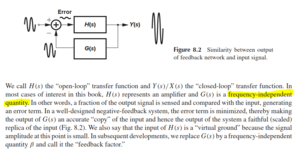[circuit theory] Transfer function of feedback network
- Thread starter melkord
- Start date
- Status
- Not open for further replies.
danadakk
Advanced Member level 6

Just derive the G(s) element expression, and plug that
into 8.2, just as you do for H(s).
The knowns are H(s), G(s), X(s)......ie you know what sig in is, you
know what H(s) and G(s) are,.....
Signal flow graphs are great for doing this, see attached.

Regards, Dana.
into 8.2, just as you do for H(s).
The knowns are H(s), G(s), X(s)......ie you know what sig in is, you
know what H(s) and G(s) are,.....
Signal flow graphs are great for doing this, see attached.
Regards, Dana.
Attachments
Last edited:
melkord
Full Member level 3
Just derive the G(s) element expression, and plug that
into 8.2, just as you do for H(s).
sorry it is a bit unclear for me.
I think I should derive G(s)=A(s)/Y(s) when the feedback network is detached from the feedforward. Is this correct?
I will check your links. Thanks
danadakk
Advanced Member level 6
Yes, you treat G(s) as a stand alone network with an input
and output. But dont use Y(s) as input because that would make
it a f( G(s), X(s), Y(s) ). So make input Z(s), output A(s), and then
solve for is T(s) = A(s) / Z(s) and plug that into the general T(s)
for the overall problem.
Regards, Dana.
and output. But dont use Y(s) as input because that would make
it a f( G(s), X(s), Y(s) ). So make input Z(s), output A(s), and then
solve for is T(s) = A(s) / Z(s) and plug that into the general T(s)
for the overall problem.
Regards, Dana.
- Joined
- Jan 22, 2008
- Messages
- 53,703
- Helped
- 14,811
- Reputation
- 29,919
- Reaction score
- 14,440
- Trophy points
- 1,393
- Location
- Bochum, Germany
- Activity points
- 303,612
I wonder what you mean with "derive G(s)"? The feedback factor is intentionally chosen in the design process.
melkord
Full Member level 3
deriving the transfer function from small signal model.I wonder what you mean with "derive G(s)"?
I am on the brink of design process....still deriving the transfer functions.The feedback factor is intentionally chosen in the design process.
- Joined
- Jan 22, 2008
- Messages
- 53,703
- Helped
- 14,811
- Reputation
- 29,919
- Reaction score
- 14,440
- Trophy points
- 1,393
- Location
- Bochum, Germany
- Activity points
- 303,612
You are stating in post #1:
In this case, G(s) will be described by a rational function with numerator and denominator coefficients (zeros and poles). Consider that the "detached" feedback network must be loaded similarly to the final circuit.I have a quite complicated feedback network with some frequency-dependent components.
That's why I want to derive G(s) first.
- Joined
- Jan 22, 2008
- Messages
- 53,703
- Helped
- 14,811
- Reputation
- 29,919
- Reaction score
- 14,440
- Trophy points
- 1,393
- Location
- Bochum, Germany
- Activity points
- 303,612
As additional remark, I'd suggest an extended feedback scheme with separate forward transfer function F(s). It gives more options to design physical plausible feedback amplifier models.

There is a number of previous threads discussing feedback circuit descriptions, e.g.: https://www.edaboard.com/threads/how-to-determine-feedback-factor.174717
There is a number of previous threads discussing feedback circuit descriptions, e.g.: https://www.edaboard.com/threads/how-to-determine-feedback-factor.174717
- Status
- Not open for further replies.
Similar threads
-
[SOLVED] Common Mode Feedback Stability Analysis
- Started by fhongjin
- Replies: 4
-
Nested Miller Compensated OP-AMPS transfer function.
- Started by Chiranka K
- Replies: 3
-
mixed circuit guardring
- Started by mssong
- Replies: 4
-
COMMON MODE FEEDBACK NOISE
- Started by diezclos11
- Replies: 0
-
Start-Up Circuit For Sub 1-V circuit
- Started by KGF KING
- Replies: 5


